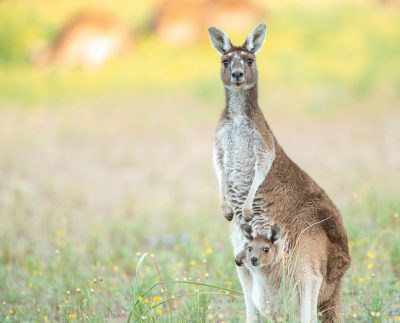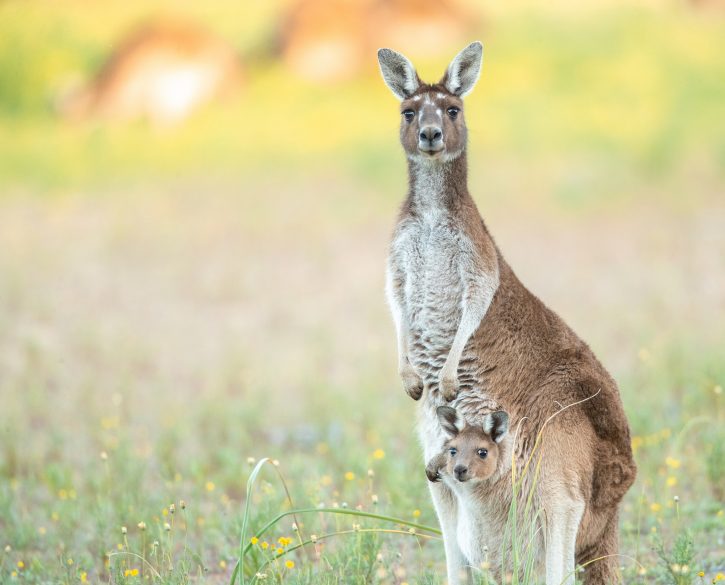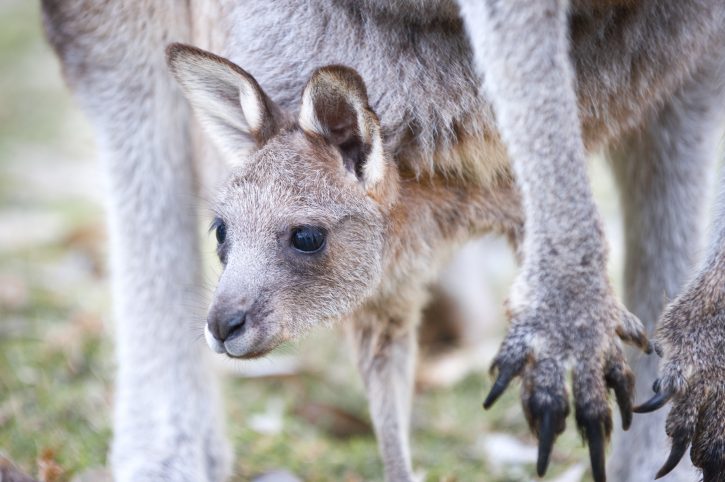What Do Kangaroos Eat?
July 14, 2020 by C.B. Daniels


The Short Answer: Kangaroos predominantly eat grasses, leaves of shrubs and bushes, mosses, flowers, and ferns.
Contents
1.2 Kangaroo Habitat and Behavior
2.1 How Do Kangaroos Get Their Food?
2.2 What Do Baby Kangaroos (Joeys) Eat?
2.3 What Do Adult Kangaroos Eat?
2.5 The Digestive System of the Kangaroo
3 How Often Should I Feed My Kangaroos?
4 Summary of What Do Kangaroos Eat
5 Other articles you might like
What Are Kangaroos?
Kangaroos are marsupials that are part of the family Macropodidae. There are four living species of kangaroo: the Red Kangaroo, the Antilopine Kangaroo, the Eastern Gray Kangaroo, and the Western Gray Kangaroo.
Tree-kangaroos, wallabies, wallaroos, quokkas, and pademelons are part of the Macropodidae family as well as several other marsupials.
While they share a name, tree-kangaroos and rat-kangaroos are very different from the four kangaroo species mentioned above, and kangaroo can also refer to two species of wallaroos. For the purpose of this article, whenever kangaroos are mentioned it will only be in reference to the four species stated above.
Fun Fact: In Latin, Macropodidae means large foot and the species in this family are all characterized by their large hind feet.
As mentioned, kangaroos are marsupials – which means that their babies or joeys are born before they are fully developed, and the joeys then finish development in a specialized pouch on their mothers that covers their nipples and mammary glands. Only the females have these pouches.
Despite their reproductive differences, marsupials are still considered mammals. Over 250 marsupial species have been found, and most (around 200) live in Australia, New Guinea, and their surrounding islands.
Kangaroo Anatomy
Kangaroos have a relatively small head with an elongated snout, and their lower mandibles or jaw bones actually do not fully connect to each other. Each lower jaw bone ends in the front with a long, sharp incisor tooth and there is a row of smaller incisors on top.
They have large ears and a good sense of hearing, and both their senses of hearing and smell are better than their eyesight. Their forelimbs are much smaller than their hind limbs, and end in five digits with sharp claws.
Their rear legs are massive and heavily muscled, and they have large, elongated feet like the other members of their family. Most of the hind foot is made up of one huge toe that ends in a single curved claw.
The other feature besides their powerful legs that makes kangaroos instantly recognizable are their long, broad tails.
It’s no secret that kangaroos hop, and they use their powerful hind limbs and tails to do so. Their tails help them balance and steer as they’re hopping and the Eastern Gray Kangaroo can actually reach speeds of 35 miles per hour.
The largest kangaroos can hop 25 feet in one stride, and up to six feet in the air. The specialized tendons, muscles, and bone structures of the hind limbs and tail all work to make this possible.
Fun Fact: Kangaroos are not able to walk backwards, but they can swim.
Most people would imagine a kangaroo’s pouch like what you see in cartoons – a wide pocket of sorts that sits like an apron across their belly. The opening is actually much, much smaller, less than a finger’s-width when closed, and the pouch expands to its full size when there’s a joey inside.
The largest kangaroo, the Red Kangaroo, weighs about 200lbs and can stand up to six feet tall. They are also the largest marsupial species in the world.
The Eastern Gray Kangaroo is actually taller than the Red Kangaroo by about six inches, but they only weigh 145lbs on average. Antilopine Kangaroos are the smallest of the four species at roughly 4 feet tall and a maximum of 80lbs.
Kangaroo fur is red, tan, or gray depending on the species and their skins are harvested for rugs and clothing. Their meat is commonly used in pet foods but there has also been a growing market for human consumption.
Fun Fact: Kangaroos have three vaginas – two that are used for sperm transport and one that the joey is birthed through. The three join together before coming out to a single opening.
Kangaroo Habitat and Behavior
The Red Kangaroo can be found in central Australia in all states and territories but Tasmania. They prefer a semi-arid climate and are often found in grasslands, plains, woodlands, and light forests.
They form loose social groups called mobs of up to 10 kangaroos and members will come and go as they please. Most have a range of about eight kilometers, though in times of drought they will range farther and form mobs in the thousands around food sources.
Red Kangaroos reach sexual maturity at two years and can live up to 23 years in the wild. During their mating season the males will fight and ‘box’ for mates – using both their clawed forelimbs and powerful back legs by leaning back on their tails.
Eastern Gray Kangaroos are found in the eastern third of Australia and prefer the forested areas of both Australia and Tasmania. While they will go into the open grasslands to graze, they spend most of their time among the trees.
These kangaroos also gather in mobs, and the males will box each other for mates. They only live 8 years on average in the wild.
The Western Gray Kangaroos on the other hand will live up to 13 years, and they form the most socially complex mobs – more like a lion pride. They can be found along the southern coast of Australia and they prefer a habitat similar to the Red Kangaroo.
The Antilopine Kangaroo lives in the northern hills and plains of Australia and is the fastest hopper of the kangaroo species. They live up to 16 years and also form strong social connections in their mobs.
All species of kangaroo are at least partially nocturnal, meaning they are most active at night and at dawn and dusk. Having said that, kangaroos do not stick firmly to this lifestyle and can be found in the middle of the day foraging for food.
Unless there is a drought that drives kangaroos together to the same food source, most will stay in their ranges. While foraging, kangaroos use their large ears and great sense of hearing to keep an ear out for predators.
Dingoes and humans are the two main predators of kangaroos, though foxes and eagles will also prey on joeys. Kangaroo males will occasionally mortally injure each other in boxing matches over mates, but they do not kill each other’s joeys.

In some areas, kangaroos are actually considered pests because they compete with livestock for pasture lands and roughly two million kangaroos are culled every year in Australia. While this may seem like a huge number, the total kangaroo population is actually around 50 million there.
What Do Kangaroos Eat?
Kangaroos are herbivores, which means that they eat plants and plant material predominantly. Their specialized digestive systems allow them to get all of the nutrients they need from the plants in their environment.
Kangaroos will eat grasses, shrubs and bush leaves, ferns, flowers, moss, and rarely insects.
Fun Fact: This diet is very high in a mineral called silica, which is often added to human foods to keep them from clumping.
How Do Kangaroos Get Their Food?
Every kangaroo species will spend at least some time foraging for food in the grasslands, even the Antilopine kangaroo that prefers the forests. Some kangaroos have been known to travel up to 12 miles to find a good source.
When foraging, instead of hopping from plant to plant which would use up a lot of energy, kangaroos can get down on all fours and walk around – just a lot slower.
Drought drives large populations of kangaroos into small areas with food, and there are often mass die-offs of their populations if the drought gets bad enough. In these extreme situations there have been cases of kangaroos picking at the carcasses of other dead kangaroos to try and get sustenance.
This is not normal kangaroo feeding behavior by any means, and their digestive systems are poorly-equipped to handle meat.
What Do Baby Kangaroos (Joeys) Eat?
Kangaroos can mate year-round, though most births take place in the summer months in the Eastern and Western Gray Kangaroos. Kangaroos often have two embryos developing at once – one that will go on to become a joey that is born and one that will be paused when it is roughly 20 cells big.
The average gestation between species is 34 days, and when the joey is born it is usually only 2 cm big and weighs less than a gram. The joey will then crawl up the mother’s body to the pouch opening, where it will go in and attach itself to one of the teats.
If the joey should die, the mother can either continue the development of the other embryo or wait until there are favorable environmental conditions. Kangaroos usually raise one joey per year.

The joey will feed exclusively on the mother’s milk and will not leave the pouch until it is at least six months old. Red Kangaroos tend to wean their joeys around 11-12 months, while the Gray Kangaroo species can suckle for up to 18 months.
Fun Fact: The joeys do not even leave the pouch to use the bathroom, and the mothers will often use their tongues to clean their pouches and any waste their joeys may have passed.
The joeys will start to nibble on grass around 8 months old and will progressively add more and more plant matter to their diets. By the time they leave the pouch for good they are eating the same diet as the adults.
Orphaned joeys that are rescued are often given liquid formula like Bioloc Marsupial Milk to replace their mother’s milk, and older joeys are also given green grass, dried grass, wooly bush, and commercial muesli.
What Do Adult Kangaroos Eat?
Adult kangaroos eat predominantly grass, and they prefer the green shoots of new grass growth. Having said that, they aren’t picky and will eat shoots, green blades, and dried grass all the same.
Shrub leaves are also on the menu, except for the Eastern Gray Kangaroos who tend to stick to grasses. Popular shrub and bush leaf choices are saltbush, mulga, and chenopod shrub.
Many flowering Grivellia plant species in gardens are targeted as well as banksias and dryandras, but kangaroos will rarely go after insects.
Fun Fact: When there are green plants available to eat, kangaroos can go long stretches without drinking any water.
In captivity, adult kangaroos can be fed green grasses, dry grasses, hay, commercial kangaroo pellets, and commercial muesli. Any change in diet should be introduced slowly to make sure there is not a bad digestive system reaction, and while legumes and vegetables can be added to the diet these are not foods that the kangaroos would normally eat in the wild.
Kangaroo Food Options
As with any wild animal, the best thing you can do for it in captivity is to try to mimic its ideal environment in the wild. To achieve this, the following are good food options to consider:
- Green grass
- Dried grass
- Grass shoots
- Hay
- Saltbrush leaves
- Mulga leaves
- Chenopod shrub leaves
- Grivella species leaves and shoots
- Banksias leaves and shoots
- Dryandras leaves and shoots
- Kangaroo pellets
- Kangaroo muesli
The Digestive System of the Kangaroo
Kangaroos have a digestive system that is very similar to cows and other ruminants like goats and sheep. Their stomachs have two chambers: the sacciform chamber and the tubiform chamber.
In the sacciform chamber, food enters from the esophagus and is fermented by the many bacteria, fungi, and Protozoa that live there. Kangaroos will often regurgitate their food and chew it some more, then swallow and repeat to help break it down in a process called chewing the cud.
Once the microorganisms in the first chamber have fermented the food, it will move to the tubiform chamber where digestion by enzymes and acid occurs. From there the food will move to the small and large intestines where nutrients and then water and electrolytes are absorbed, and then the rest is excreted as feces.
How Often Should I Feed My Kangaroos?
Kangaroos are grazers in the wild, which means that they have access to food intermittently throughout the day. In captivity they have not been known to gorge themselves, so you are safe to make food consistently available to them.
Just be sure to clean out any rotting vegetation, and change out their water bowl weekly. You can also see if there are any leaves or plants that they avoid and remove those.
Summary of What Do Kangaroos Eat
Kangaroos are marsupials that are part of the family Macropodidae, and there are four main species of Kangaroos.
They are different from other mammals because of the pouch that females use to finish developing their young.
Kangaroos are herbivores, meaning they eat mostly plant matter, and they eat grasses, shrub and bush leaves, flowers, ferns, and mosses.
Baby kangaroos or joeys will drink their mother’s milk for 11-18 months depending on the species, and will slowly start to incorporate grasses and other vegetation into their diets until they are weaned.
Kangaroos are wild animals that can occasionally be pests, but they can be raised and kept in captivity when needed and even rehabilitated in some cases.
Other articles you might like
Hi my name is C.B. Daniels and I make websites. I’ve also always been fascinated by animals. I thought that some of the information about animal diets and pet names was a little thin. So I figured I’d make this site to remedy that! I hope to make this site a hub for information about what animals eat, fun names you can use for your pets, and general animal information. Hopefully, you’ll find all the information about animals you are looking for and much more!
Latest posts by C.B. Daniels (see all)
- Can Rabbits Eat Grapes? - November 12, 2022
- Can Rabbits Eat Cucumbers? - November 3, 2022
- Can Rabbits Eat Spinach? - November 3, 2022